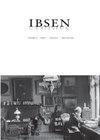Doctoral Defense: Ibsen through the Camera Lens in the Third Reich
IF 0.1
0 THEATER
引用次数: 5
Abstract
Far from Home: Ibsen through the Camera Lens in the Third Reich (2020) is the first monograph on adaptation practices in Nazi cinema and explores the extensive (mis)use of Ibsen on screen in Hitler’s Germany: which Ibsen texts were adapted in the Third Reich and why, how was Ibsen adapted, and, finally, what are the ideological implications of these films? The dissertation probes five scarcely explored Ibsen adaptations – Hans Hinrich’s Das Meer ruft (1933), Fritz Wendhausen’s Peer Gynt (1934), Detlef Sierck’s St€utzen der Gesellschaft (1935), Hans Steinhoff’s Ein Volksfeind (1937), and Harald Braun’s Nora (1944) – in their respective historical moments, shows why these films are important within the legacy of Nazi cinema, sheds new light on relations between German, Norwegian, and, by extension, Scandinavian culture in this era, and argues that the extreme historical context highlights the need to frame adaptation studies in a wider social and cultural field. The work draws upon poststructuralist turns in adaptation theory and cultural studies, and situates the respective films in their immediate historical contexts. Applying heterogeneous models of ideology rather than deterministic propaganda models, it argues that the five films played a role in creating and maintaining the Volksgemeinschaft, but also serve as prisms of the inner contradictions in the matrix of Nazi ideology and Hitler’s Germany.博士答辩:第三帝国镜头下的易卜生
《远离家乡:第三帝国的易卜生通过镜头》(2020)是第一本关于纳粹电影改编实践的专著,探讨了在希特勒的德国,易卜生在银幕上的广泛(错误)使用:哪些易卜生的文本在第三帝国被改编,为什么,易卜森是如何改编的,最后,这些电影的意识形态含义是什么?本文探讨了五部鲜为人知的易卜生改编作品——汉斯·海因里希的《达斯·米尔鲁夫特》(1933年)、弗里茨·温德豪森的《培尔·金特》(1934年)、德特勒夫·西耶克的《圣尤岑德·格塞尔沙夫特》(1935年)、汉斯·斯坦霍夫的《大众的爱》(1937年)和哈拉尔·布劳恩的《诺拉》(1944年)——在各自的历史时刻,展示了这些电影在纳粹电影遗产中的重要意义,揭示了这个时代德国、挪威以及斯堪的纳维亚文化之间的关系,并认为极端的历史背景突出了在更广泛的社会和文化领域构建适应研究的必要性。这部作品借鉴了改编理论和文化研究中的后结构主义转向,并将各自的电影置于其直接的历史背景中。运用异质的意识形态模型,而不是确定性的宣传模型,它认为这五部电影在创造和维护人民政权方面发挥了作用,但也成为纳粹意识形态和希特勒统治下的德国矩阵中内部矛盾的棱镜。
本文章由计算机程序翻译,如有差异,请以英文原文为准。
求助全文
约1分钟内获得全文
求助全文

 求助内容:
求助内容: 应助结果提醒方式:
应助结果提醒方式:


